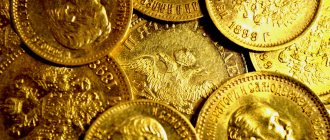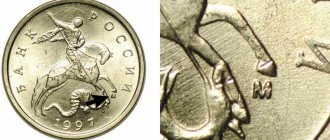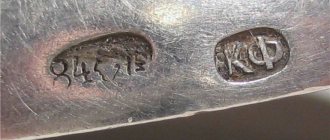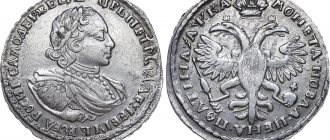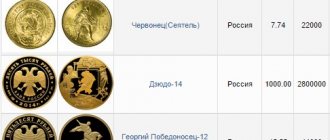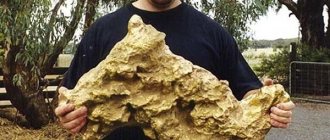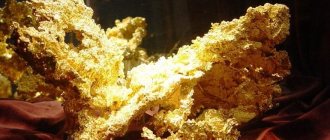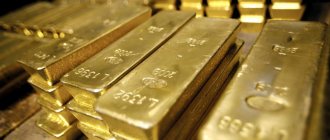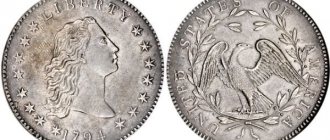I am glad to welcome our guests and subscribers again. This time I will present you with an overview on the topic of investing available funds in Russian gold coins. Let’s figure out what types of coins there are, what they are intended for, and I’ll tell you about the rarest and most valuable specimens.
Let's consider them as an investment object so that you can form your own opinion about this method of financial investment and its attractiveness.
Classification
Depending on their purpose, gold coins can be divided into 4 classes:
- change;
- collectible and commemorative;
- investment;
- trial.
Modern coins made of gold are not found, but we will now look at three other classes.
Investment
These products are minted at the mints of Moscow and St. Petersburg from pure gold. They have a simple design, are produced in impressive quantities and do not represent significant artistic value. This is an investment item, and the lion's share of its value is 999 gold.
Russia is actively promoting the popularity of these investments by exempting the buyer from paying VAT when making such a purchase, which makes this type of investment in precious metals attractive, but in the long term, since the marginal difference between buying a coin from a bank and selling it reaches 50% of the original price.
Historical collectibles
Rare gold pieces from Tsarist Russia or the early Soviet Union, which were issued in the past as a means of payment.
Currently they have antique value. Collectors willingly add them to their treasures. They are bought and sold mainly through antique salons and auctions. Some samples are valued at tens and even hundreds of thousands of dollars.
Commemorative or numismatic
Anniversary or commemorative banknotes have a thematic connection to a place or event. They are distinguished by a limited edition and more complex coinage. Therefore, their cost is obviously higher than investment ones.
First of all, they are of interest to numismatists as a collector's item. Over the years, the value of such items can increase significantly, but in highly specialized circles of enthusiastic collectors.
Expert opinion
Alexander Ivanovich
Private collector with 4500+ coins and bonds in his personal collection. Knows the value of each of them today.
Coins that have manufacturing defects, typos and errors, as well as trial coins that were not released into mass production receive additional numismatic value. If such a coin exists in a single copy, then its value is difficult to even predict.
Trial
This class includes coins that were made as a sample, but for some reason were not put into production. They usually exist in one or more copies or sets and also have a high value due to their rarity and attractiveness from the point of view of collectible value.
Purchasing at numismatics clubs
There is no point in considering this method, since first you need to be a member of such a club. And if you are a member of such an association of numismatists and collectors, then you will probably be familiarized with the current rules for purchasing coins and prices, which may differ. However, investors have nothing to do there, since such clubs specialize in collectible and rare coins, and the required (or in the required quantity) investment coins are simply not there. But if you're interested, you can find out how much collectors can earn by investing in coins.
Is it profitable to invest in gold coins?
In this matter, the classification of the subject plays a significant role. But no matter what copies you choose as an investment object for the purpose of generating income, we will be talking about tens and even hundreds of thousands of rubles.
Advantages and disadvantages
Advantages and disadvantages in order:
- Investment: when buying coins in Russia, gold is not subject to VAT and this is perhaps the only small plus. The initial cost of the Victorious coin in the bank is 26,960 rubles. You can return it for exactly 20 thousand. Let’s say gold has tripled in price, then the cost of the investment will increase proportionally. You get an income, but it will still be less than from owning, say, bullion, even taking into account the tax. And if three years have not passed since the purchase, you will also have to pay income tax. And it needs to be stored somewhere - either at home, or for money, renting a safe deposit box for such purposes.
- Commemorative and numismatic: the advantage is the absence of VAT. Disadvantage similar to the previous one. The “Peter” coin is valued at 44,490 rubles, accepted by the bank for 20 thousand. We emphasize that we did not select the most significant difference. This situation applies to almost all coins. Add storage costs to the disadvantages.
- Historical collectibles: their value will only increase, but how exactly cannot be predicted. The disadvantages of such gold coins are the difficulty of purchasing, high price, low liquidity and storage costs. If you lack basic knowledge on the topic, you will have to use the services of an expert.
Purchasing through Avito and ebay trading platforms
Purchasing coins made of precious metals through ad sites has the following advantages:
- Here, with a fairly large selection, there is a chance to find rare pieces that are not available from banks and dealers.
- In most cases, prices are quite affordable.
- Among the sellers there are not only speculators, but also investors themselves, collectors, as well as their heirs who need funds and offer favorable prices for rare coins.
- It is not necessary to provide documents and personal data.
- It is possible to purchase it personally or send it to another location.
However, there are also disadvantages:
- A meeting with the seller can be scheduled either in an office or cafe, or on the street near the house or exit from the metro. Under such conditions, it can be difficult to assess the condition of the coin and make an informed purchasing decision.
- With this method of acquisition, there is a high risk of encountering criminal and fraudulent activities. You must ensure your own safety.
- Documents and receipts are most often missing.
- You will have to check the coin yourself. Study all its parameters in advance and check them when purchasing, using a magnifying glass, scales and calipers.
- Cash payment or full prepayment on a card is expected when sending goods to another city. The seller's integrity and responsibility are not guaranteed.
Brief overview of domestic gold coins
So, a brief overview of the most valuable and famous Russian gold coins.
Old Russian
Very few examples minted in Ancient Rus' are known. This is due to the fact that the country’s own gold mines appeared only in the 18th century. Until this point, gold coins were minted not as units of monetary circulation, but as reward commemorative signs. Moreover, the release was rather piecemeal.
Most of the currently known samples were made at the Armory, but often the coinage was ordered from Polish and Hungarian craftsmen.
Zlatnik
The first cash coin is considered to be the zlatnik, minted in Kyiv, presumably in the 10th-11th centuries, at the time of the baptism of Rus'. Only 11 copies of this coin were found. Not enough for a monetary unit. It is possible that they were also produced in limited quantities for special purposes.
Russian kingdom
In the chronicles of the 15th century, for the first time there are references to the so-called grant coins - gold award signs that were awarded for a feat or outstanding achievement. This tradition continued until the beginning of the 18th century, when orders and medals were introduced as rewards for service.
Shipbuilder of Ivan III
The gold coin was presumably produced as a grant coin. It was created on the model of an English noble in the second half of the 15th century in Russia during the joint reign of Ivan III and his son. A gold specimen weighing 7 grams is an exhibit of the Hermitage.
Ugorsky
Ugric (Hungarian) is another example of granted gold coins that were issued in Russia to reward for feats of arms.
False Dmitry I
The impostor, posing as Tsarevich Dmitry and leading the uprising, also minted his own Ugric coins to reward his supporters.
Vasily Shuisky
Prince Vasily Shuisky, from the Suzdal Rurikovichs, established the issuance of gold money (moskovki) and kopecks, which were intended to pay salaries to mercenaries. This is the first example in the history of Russia when gold was used as a monetary unit, and not as a reward. However, after Shuisky was overthrown from the throne, this practice was stopped.
Romanovs
Ugric metrology was preserved in Russia during the reign of the Romanovs until Peter I. There are known specimens in denominations of 1, 2, 3 Ugric. Lower ranks were awarded coins of ½, ¼ Ugric. The weight of the gold was proportional to the status of the recipient and his merits.
The first gold medal in the history of Russia with a woman's name was also a Ugric medallion. The name of Princess Sophia was engraved on it. There is reliable information about two such objects, each of which weighed equal to seven Ugric ones.
Russian empire
Russia's first emperor, Peter I, carried out a large-scale monetary reform and introduced into circulation the monetary unit - the chervonets. From this point on, payments in gold continued until the 20th century. In total, 79 varieties of gold coins were issued in Imperial Russia.
Under Peter, the issue of paid banknotes continued. These included baptismal chervonets, which the emperor gave to his numerous godchildren, and then to his courtiers.
Under Nicholas II, imperials and semi-imperials came into use. The largest known gold imperial, with a face value of 37.5 rubles (equivalent to 100 francs), was minted as a personal royal gift.
RSFSR and USSR
In Soviet Russia, a gold monetary unit called the “Sower” chervonets was also produced. Its implementation contributed to the success of the NEP - the new economic policy. The Russian chervonets became a hard currency that was quoted on world stock exchanges, and it was possible to exchange or buy it without any problems almost all over the world.
The most valuable of the known Soviet chervonets are copies dated 1925, with the coat of arms of the USSR. They belonged to a trial batch, which was never put into circulation.
A huge circulation of gold money, amounting to more than 7 million pieces, was issued in Russia for the Moscow Olympics. Coins were a legal instrument of payment both within the country and in foreign trade.
Russian Federation
In modern Russia, many gold coins are issued: commemorative and investment. Here is a short thematic video about this.
What investment coins can you buy today?
The most famous of the modern investment coins is St. George the Victorious.
You can also purchase:
- Sower.
- Russian ballet.
- Zodiac signs.
- River beaver.
- Winter Olympic Games.
- History of monetary circulation in Russia.
- FIFA World Cup 2021.
Why are chervonets and 15 rubles with Nicholas III a priority in Russia?
Coins of 5 and 10 rubles, which became 7.5 and 15 rubles respectively as a result of Witte’s monetary reform, formed the basis of the monetary circulation of the Russian Empire. They were produced in millions of copies and were widely distributed.
Interesting fact: the 10-ruble imperials, which were minted in 95-97 of the 19th century, represent a statistical anomaly. Although this example is not very rare (its circulation was 125 pieces annually, about 375 in total), collectors are willing to shell out up to a quarter of a million dollars for it.
How much do investment gold coins cost in Sberbank of Russia today?
Expert opinion
Lyudmila Pestereva
Our most experienced gold investor
Ask a Question
The cost of investment coins in Sberbank ranges from 25 to 40 thousand per copy, made of gold, worth 50 rubles and weighing 7.78 grams of pure gold. Why there is such a difference in price is difficult to answer. Sberbank of Russia does not comment on pricing on its website: it probably depends on the expected demand for individual copies.
The bank also offers wholesale pricing options for batches of 10 items and above. The price is reduced by 1-2 thousand per unit.
The most expensive copy - Suvorov 2000, which, however, does not belong to investment coins, but to commemorative signs, with a similar weight and denomination - is offered to be purchased for 400 thousand.
Buying coins from dealers
Firms or individual entrepreneurs act as dealers. Buying and selling precious metals in the form of coins is their specialization and main income. Therefore, they are interested in offering the client a favorable price.
Among the advantages of dealers are the following:
- The purchase price from dealers is often closer to or lower than the market average. However, no one will sell you a copy for less than the cost of the precious metal from which it is made.
- Wide range and great selection.
- Possibility of obtaining certain copies upon pre-order.
- Possibility of fixing the price for up to a day.
- Availability of delivery by courier or sending to another location.
- Discounts, bonuses and loyalty programs.
- Special prices for wholesale purchases.
- Preparation of documentation indicating the real price for further tax deductions.
All professional dealers require a passport to make a purchase. However, in some private companies, transactions can be concluded anonymously, and registration with the issuance of a certificate is carried out only if the contract value is from 600,000 rubles.
An important advantage of trading operations with a dealer is not only the sale, but also the repurchase of coins of any degree of preservation. The condition of the copy will affect the price, and the difference between the cost of acquisition and redemption is quite acceptable compared to banks.
Disadvantages of purchasing from dealers:
- Purchasing coins can be done with cash. Cards and bank transfers are either not accepted or incur a 3% to 5% fee that increases the price.
- Large coin dealers are found mainly in large cities. The smaller the settlement, the poorer the assortment there and the higher the premium to the price of metal.
The domestic market for investment coins is still developing. Private coin dealers and small dealers may frequently change their address, status, or online resource. Professional (officially registered) dealers have a license and all the necessary accompanying documents, they are regularly tested for compliance with trade rules, have a permanent office, telephone numbers and an online store with a catalog of coins. Such companies retain and maintain long-term mutually beneficial relationships with their clients.
